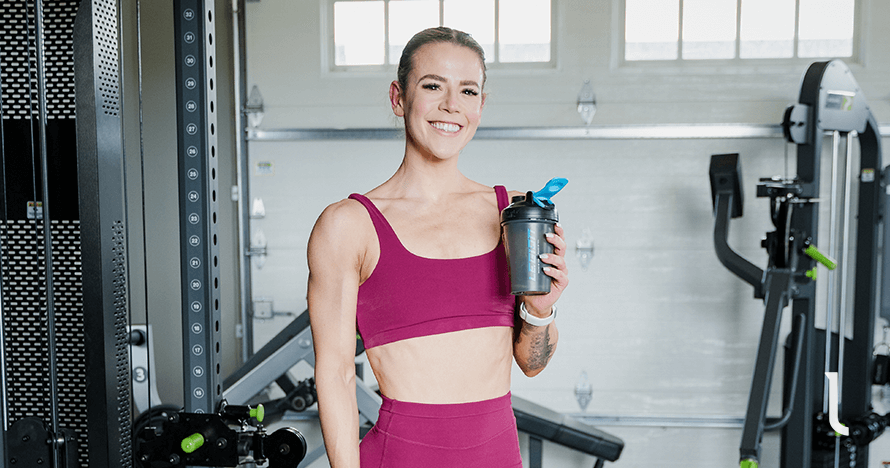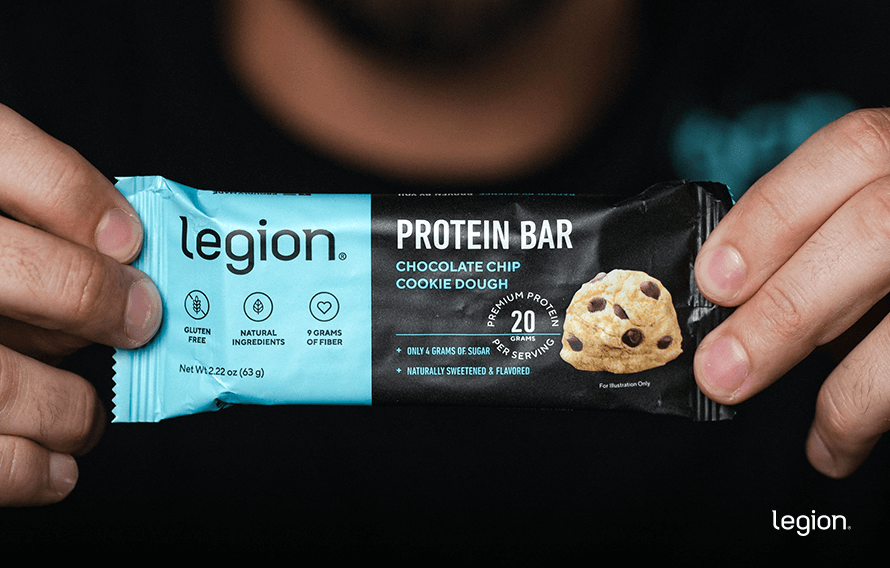Enter your age, weight, and exercise degree, and the Legion Protein Calculator will let you know precisely how a lot protein you must eat per day to drop pounds, construct muscle, or keep your physique.
What Is Protein?
Protein is a macronutrient important for constructing, repairing, and sustaining tissues in your physique, together with muscle mass, pores and skin, and organs.
It’s made up of amino acids—the “constructing blocks” your physique makes use of to develop and restore cells.
Protein additionally plays a key position in numerous bodily capabilities, resembling producing hormones, supporting immune operate, and offering power when wanted.
There are 20 amino acids that comprise the protein in your physique. Your physique can produce 11 amino acids by itself, however it should get the remaining 9 out of your food plan, which is why consuming protein is significant for all times.
How A lot Protein Do I Want? Calculator Outcomes Defined
The present Really helpful Dietary Allowance (RDA) for protein within the US is 0.8 grams per kilogram of physique weight per day, or about 0.36 grams per pound of physique weight per day.
That stated, a big body of evidence shows that that is insufficient for sustaining or constructing muscle mass, optimizing fat loss, and maximizing your well being and efficiency, particularly when you’re energetic.
What’s extra, latest evidence means that even the present RDA could also be inadequate for supporting well being, and that it ought to be adjusted upward to 1.0 g/kg/day, or about 0.45 g/lb/day.
For instance, in a research printed within the British Journal of Vitamin, wholesome, sedentary adults ate 40% extra energy than they wanted to take care of their weight and three totally different quantities of protein: 0.7 g/kg (a tad lower than the RDA), 1.8 g/kg, and three.0 g/kg.
The individuals who consumed the RDA of protein misplaced muscle mass regardless of being in a calorie surplus, whereas the individuals who ate extra protein gained muscle.
That stated, consuming as a lot protein as potential isn’t higher. Whereas research present it’s suitable for eating 1.5-to-2+ grams of protein per pound of physique weight per day, this isn’t necessary to optimize muscle development, fats loss, or well being.
RELATED: Is High-Protein Dieting Bad for Your Kidneys?
In different phrases, consuming a really high-protein food plan (greater than 1 g/lb/day) isn’t “unhealthy,” however analysis reveals it in all probability isn’t any higher than consuming a reasonable quantity of protein (0.8-to-1 g/lb/day).
Many health people intentionally eat somewhat extra protein than analysis reveals is important as a approach to make sure they aren’t lacking out on any of its advantages. For instance, as an alternative of consuming 0.8 g/lb/day, which for a 200-pound man could be 160 grams of protein, they select to eat 1 g/lb/day, which is 200 grams.
This solely provides 160 calories to their each day meals consumption, so it doesn’t meaningfully cut back how a lot carbohydrate and fats they’ll eat per day.
What you don’t need to do is eat a lot extra protein that it’s important to considerably cut back your carbohydrate and fats consumption, as this could negatively affect your exercise efficiency, restoration, and hormonal well being.
Our protein calculator makes use of this up-to-date science to place you within the Goldilocks zone for protein consumption—sufficient to maximise fats loss, muscle achieve, and satiety, whereas nonetheless leaving ample room for carbs and fats in your food plan.
The Advantages of Utilizing the Legion Protein Calculator for Weight Loss

When you’re making an attempt to lose fats whereas minimizing muscle loss, research shows it’s best to eat between 0.5-to-1 grams of protein per pound of physique weight per day.
When you’re lifting weights or doing a number of exhausting or extended exercises per week, resembling working, martial arts, or group sports activities, then you definately’ll want to purpose for the higher finish of this vary—round 0.8-to-1 grams of protein per pound of physique weight per day.
When you’re bodily energetic, however aren’t lifting weights or doing vigorous or extended exercises, and aren’t making an attempt to drop pounds, then you may get by with much less protein—round 0.5-to-0.7 grams of protein per pound of physique weight per day.
And when you’re sedentary (which isn’t ultimate if you wish to care for your well being), research reveals you’ll be able to eat as little as 0.4 grams of protein per pound of physique weight per day with out shedding muscle.
Apart from preserving muscle mass, another excuse to eat extra protein than the RDA is that it improves satiety, which makes it simpler to take care of a calorie deficit.
Protein additionally “prices” extra energy to digest than carbohydrate and fats, and so consuming extra protein barely boosts metabolic rate (although the impact isn’t enough to have a significant affect on weight reduction).
Some protein calculators suggest a lot increased intakes than this—all the way in which as much as 1.5 g/lb per day or extra. These recommendations are primarily based on outdated research (or simply good ol’ customary broscience), which overestimated the quantity of protein you must forestall muscle loss whereas weight-reduction plan.
Newer studies have proven that these suggestions are extreme and might make weight-reduction plan more difficult by lowering the energy out there for carbs and fat.
Whereas it’s superb to eat barely extra protein than mandatory “simply in case,” consuming an excessive amount of could make weight-reduction plan harder and ugly by limiting your meals choices.
When you eat so much protein that it’s important to severely limit your carbohydrate and fats consumption, this could additionally damage exercise efficiency, restoration, and hormonal well being.
Thus, when making an attempt to drop pounds, you need to eat sufficient protein to protect muscle and keep happy between meals, however not way more than this.
Protein is only one piece of the fats loss puzzle, although. You additionally have to eat the correct variety of energy and the correct stability of carbs and fats. For personalised recommendation on energy and macros, try our macronutrient calculator:
The Legion Macronutrient Calculator
The Advantages of Utilizing the Legion Protein Calculator for Muscle Acquire

In case your objective is to realize muscle, it’s important that you simply eat a high-protein food plan.
Research reveals that growing protein consumption past the RDA considerably will increase muscle growth, particularly when mixed with strength training.
For instance, a meta-analysis of 49 research discovered that consuming 0.7-to-0.8 grams of protein per pound of physique weight per day optimizes muscle achieve for weightlifters.
Your physique’s capacity to make use of protein for muscle constructing hits a ceiling round this level, although, so consuming extra doesn’t result in a lot if any extra muscle achieve.
That stated, your protein wants may be barely increased relying on components like your genetics, exercise degree, coaching quantity, and weightlifting expertise, which is why many individuals making an attempt to realize muscle select to eat barely extra—usually round 1 gram of protein per pound of physique weight per day.
When you’re uncertain concerning the actual quantity of protein to construct muscle, our calculator can provide you personalised suggestions primarily based on the newest analysis.
After all, protein alone received’t get you the outcomes you’re after. It’s good to observe a well-rounded food plan with the correct stability of carbs, fats, and energy mixed with an efficient power coaching plan to optimize muscle development.
Take the Legion Diet Quiz and Training Quiz to get a custom-made food plan and coaching plan in lower than 60 seconds.
The right way to Use the Legion Protein Calculator for Seniors
Research reveals that folks over 60 years previous ought to eat a minimal of 0.5-to-0.8 grams of protein per pound of physique weight per day, relying on their exercise degree.
The decrease finish is often ample for stopping muscle loss in sedentary individuals, whereas the upper finish is useful for maximizing muscle achieve and upkeep for older people who raise weights.
As we age, sustaining muscle mass and power turns into more and more necessary—it helps us keep cellular, lowers the danger of falls and fractures, and reduces the chance of sickness and frailty.
Research constantly reveals that protein performs a vital position on this course of.
As an example, a meta-analysis of seven research discovered that older adults who consumed greater than 0.5 grams of protein per pound of physique weight per day maintained higher mobility, whereas these consuming much less skilled better muscle loss and frailty.
One other systematic review printed within the Journal of the American Faculty of Vitamin confirmed that seniors who ate extra protein than the RDA (0.4 g/lb/day) considerably lowered their danger of hip fractures, which highlights the position of protein in bone well being.
Greater protein intakes additionally cut back the danger of continual illnesses.
A study printed in The American Journal of Medical Vitamin tracked 50,000 individuals over 30 years and located that older people who consumed as much as 23% of their each day energy from protein had been much less more likely to develop continual illnesses like coronary heart illness, diabetes, or most cancers. In addition they maintained higher cognitive and bodily operate.
For each 3% enhance in complete protein consumption, the research confirmed a 5% relative enchancment within the chance of growing older with out continual sickness.
Use our protein per day calculator to simply discover your optimum each day protein consumption that can assist you keep robust and very important as you age.
The right way to Meet Your Every day Protein Objective

Listed below are three sensible tricks to constantly hit your each day protein goal:
- Eat 30-to-40 grams of protein per meal. The easiest way to fulfill your each day protein wants is to be sure to eat 3-to-4 meals with 30-to-40 grams of protein in every. When you do that, it’s exhausting not to get near your each day protein goal day-after-day.
- Complement with protein powder, bars, and cookies. If you’re on-the-go or simply don’t really feel like making ready or consuming regular meals, protein powder, bars, and cookies are a handy and engaging solution to increase your protein consumption.
- Snack on high-protein meals: Preserve high-protein snacks readily available for in-between meals. Skyr, Greek yogurt, cottage cheese, jerky, meat sticks, hard-boiled eggs, and edamame are all good choices that require minimal prep.
What Are the Finest Excessive-Protein Meals?
Under are among the finest meals for making ready high-protein meals.
- Poultry: Rooster breast, turkey breast, floor turkey, hen thighs.
- Purple Meat: Floor beef (90% lean or increased), prime sirloin steak, pork tenderloin, pork chops, bison, lamb.
- Fish: Tuna, salmon, cod, mackerel, halibut, sardines.
- Shellfish: Shrimp, crab, lobster, scallops, clams, mussels.
- Eggs: Entire eggs and egg whites.
- Low-Fats Dairy: Low-fat milk, Greek yogurt, Skyr, cottage cheese, low-fat cheese (mozzarella, Swiss), kefir.
- Legumes: Black beans, lentils (purple, inexperienced, or brown), chickpeas, kidney beans, pinto beans, edamame, peas.
- Entire Grains: Brown rice, quinoa, millet, farro, barley, buckwheat, bulgur.
- Nuts and Seeds: Almonds, cashews, pistachios, walnuts, hemp seeds, chia seeds, flaxseeds, sunflower seeds, pumpkin seeds, sesame seeds.
- Greens: Broccoli, cauliflower, Brussels sprouts, asparagus, spinach, kale, inexperienced peas, edamame.
How A lot Protein Can Your Physique Soak up In a Single Meal?
Your physique can absorb and successfully use 100 or extra grams of protein in a single meal.
That stated, most research shows that you’ll maximize the muscle-building advantages of protein when you divide your each day protein consumption throughout 3-to-4 meals per day, not less than 3 hours aside, with not less than 20-to-30 grams of protein in every meal.
It’s because eating protein will increase muscle protein synthesis (the creation of latest muscle proteins), and reduces muscle protein breakdown (the breakdown of muscle proteins).
This impact solely lasts for a number of hours, although, which is why it’s ultimate to eat a number of protein-rich meals all through the day, which boosts protein synthesis and suppresses protein breakdown for so long as potential.
Scientific References +
- Watford, Malcolm, and Guoyao Wu. “Protein.” Advances in Nutrition, vol. 9, no. 5, 27 July 2018, pp. 651–653, www.ncbi.nlm.nih.gov/pmc/articles/PMC6140426/, https://doi.org/10.1093/advances/nmy027.
- Lopez, Michael J., and Shamim S. Mohiuddin. “Biochemistry, Essential Amino Acids.” PubMed, StatPearls Publishing, 2022, www.ncbi.nlm.nih.gov/books/NBK557845/.
- Weiler, Mary, et al. “Is It Time to Reconsider the U.S. Recommendations for Dietary Protein and Amino Acid Intake?” Nutrients, vol. 15, no. 4, 6 Feb. 2023, p. 838, https://doi.org/10.3390/nu15040838.
- Humayun, Mohammad A, et al. “Reevaluation of the Protein Requirement in Young Men with the Indicator Amino Acid Oxidation Technique.” The American Journal of Clinical Nutrition, vol. 86, no. 4, 1 Oct. 2007, pp. 995–1002, https://doi.org/10.1093/ajcn/86.4.995. Accessed 30 Nov. 2020.
- Rafii, Mahroukh, et al. “Dietary Protein Requirement of Men >65 Years Old Determined by the Indicator Amino Acid Oxidation Technique Is Higher than the Current Estimated Average Requirement.” The Journal of Nutrition, vol. 146, no. 4, 1 Apr. 2015, pp. 681–687, https://doi.org/10.3945/jn.115.225631. Accessed 3 Nov. 2020.
- Rafii, Mahroukh, et al. “Dietary Protein Requirement of Female Adults >65 Years Determined by the Indicator Amino Acid Oxidation Technique Is Higher than Current Recommendations.” The Journal of Nutrition, vol. 145, no. 1, 15 Oct. 2014, pp. 18–24, https://doi.org/10.3945/jn.114.197517. Accessed 11 Dec. 2019.
- Tang, Minghua, et al. “Assessment of Protein Requirement in Octogenarian Women with Use of the Indicator Amino Acid Oxidation Technique.” The American Journal of Clinical Nutrition, vol. 99, no. 4, 15 Jan. 2014, pp. 891–898, https://doi.org/10.3945/ajcn.112.042325. Accessed 30 Nov. 2020.
- Elango, Rajavel, et al. “Evidence That Protein Requirements Have Been Significantly Underestimated.” Current Opinion in Clinical Nutrition and Metabolic Care, vol. 13, no. 1, Jan. 2010, pp. 52–57, https://doi.org/10.1097/mco.0b013e328332f9b7.
- Forbes, Gilbert B., et al. “Deliberate Overfeeding in Women and Men: Energy Cost and Composition of the Weight Gain*.” British Journal of Nutrition, vol. 56, no. 1, 1 July 1986, pp. 1–9, www.cambridge.org/core/journals/british-journal-of-nutrition/article/deliberate-overfeeding-in-women-and-men-energy-cost-and-composition-of-the-weight-gain/F44C5604D2D6FFF636374D722CB3995F, https://doi.org/10.1079/BJN19860080.
- Antonio, Jose, et al. “The Effects of Consuming a High Protein Diet (4.4 G/Kg/D) on Body Composition in Resistance-Trained Individuals.” Journal of the International Society of Sports Nutrition, vol. 11, no. 1, 12 May 2014, https://doi.org/10.1186/1550-2783-11-19.
- Antonio, Jose, et al. “A High Protein Diet Has No Harmful Effects: A One-Year Crossover Study in Resistance-Trained Males.” Journal of Nutrition and Metabolism, vol. 2016, 2016, pp. 1–5, www.ncbi.nlm.nih.gov/pmc/articles/PMC5078648/, https://doi.org/10.1155/2016/9104792.
- Campbell, Wayne W, et al. “Higher Total Protein Intake and Change in Total Protein Intake Affect Body Composition but Not Metabolic Syndrome Indexes in Middle-Aged Overweight and Obese Adults Who Perform Resistance and Aerobic Exercise for 36 Weeks.” The Journal of Nutrition, vol. 145, no. 9, 5 Aug. 2015, pp. 2076–2083, www.ncbi.nlm.nih.gov/pmc/articles/PMC4548166/pdf/jn213595.pdf, https://doi.org/10.3945/jn.115.213595. Accessed 1 Oct. 2021.
- Walberg, J., et al. “Macronutrient Content of a Hypoenergy Diet Affects Nitrogen Retention and Muscle Function in Weight Lifters.” International Journal of Sports Medicine, vol. 09, no. 04, Aug. 1988, pp. 261–266, https://doi.org/10.1055/s-2007-1025018. Accessed 27 Aug. 2020.
- METTLER, SAMUEL, et al. “Increased Protein Intake Reduces Lean Body Mass Loss during Weight Loss in Athletes.” Medicine & Science in Sports & Exercise, vol. 42, no. 2, Feb. 2010, pp. 326–337, pubmed.ncbi.nlm.nih.gov/19927027/, https://doi.org/10.1249/mss.0b013e3181b2ef8e.
- Hudson, Joshua L, et al. “Protein Intake Greater than the RDA Differentially Influences Whole-Body Lean Mass Responses to Purposeful Catabolic and Anabolic Stressors: A Systematic Review and Meta-Analysis.” Advances in Nutrition, vol. 11, no. 3, 3 Dec. 2019, pp. 548–558, https://doi.org/10.1093/advances/nmz106. Accessed 7 Aug. 2020.
- Kohanmoo, Ali, et al. “Effect of Short- and Long-Term Protein Consumption on Appetite and Appetite-Regulating Gastrointestinal Hormones, a Systematic Review and Meta-Analysis of Randomized Controlled Trials.” Physiology & Behavior, vol. 226, Nov. 2020, p. 113123, https://doi.org/10.1016/j.physbeh.2020.113123.
- Helms, Eric R., et al. “A Systematic Review of Dietary Protein during Caloric Restriction in Resistance Trained Lean Athletes: A Case for Higher Intakes.” International Journal of Sport Nutrition and Exercise Metabolism, vol. 24, no. 2, Apr. 2014, pp. 127–138, https://doi.org/10.1123/ijsnem.2013-0054.
- Morton, Robert W, et al. “A Systematic Review, Meta-Analysis and Meta-Regression of the Effect of Protein Supplementation on Resistance Training-Induced Gains in Muscle Mass and Strength in Healthy Adults.” British Journal of Sports Medicine, vol. 52, no. 6, 11 July 2017, pp. 376–384, https://doi.org/10.1136/bjsports-2017-097608.
- Whittaker, Joseph, and Miranda Harris. “Low-Carbohydrate Diets and Men’s Cortisol and Testosterone: Systematic Review and Meta-Analysis.” Nutrition and Health, 7 Mar. 2022, p. 026010602210830, https://doi.org/10.1177/02601060221083079. Accessed 15 Mar. 2022.
- Whittaker, Joseph, and Kexin Wu. “Low-Fat Diets and Testosterone in Men: Systematic Review and Meta-Analysis of Intervention Studies.” The Journal of Steroid Biochemistry and Molecular Biology, vol. 210, June 2021, p. 105878, https://doi.org/10.1016/j.jsbmb.2021.105878.
- Koerich, Ana Clara C., et al. “Effects of the Ketogenic Diet on Performance and Body Composition in Athletes and Trained Adults: A Systematic Review and Bayesian Multivariate Multilevel Meta-Analysis and Meta-Regression.” Critical Reviews in Food Science and Nutrition, 27 June 2022, pp. 1–26, https://doi.org/10.1080/10408398.2022.2090894. Accessed 26 Oct. 2022.
- Tagawa, Ryoichi, et al. “Dose–Response Relationship between Protein Intake and Muscle Mass Increase: A Systematic Review and Meta-Analysis of Randomized Controlled Trials.” Nutrition Reviews, vol. 79, no. 1, 3 Nov. 2020, pp. 66–75, https://doi.org/10.1093/nutrit/nuaa104.
- Bandegan, Arash, et al. “Indicator Amino Acid–Derived Estimate of Dietary Protein Requirement for Male Bodybuilders on a Nontraining Day Is Several-Fold Greater than the Current Recommended Dietary Allowance.” The Journal of Nutrition, vol. 147, no. 5, 8 Feb. 2017, pp. 850–857, https://doi.org/10.3945/jn.116.236331.
- Moore, Daniel R. “Protein Requirements for Master Athletes: Just Older Versions of Their Younger Selves.” Sports Medicine, vol. 51, 13 Sept. 2021, https://doi.org/10.1007/s40279-021-01510-0.
- Jang, Young Jin. “The Effects of Protein and Supplements on Sarcopenia in Human Clinical Studies: How Older Adults Should Consume Protein and Supplements.” Journal of Microbiology and Biotechnology, vol. 33, no. 2, 31 Oct. 2022, https://doi.org/10.4014/jmb.2210.10014.
- Coelho-Júnior, Hélio, et al. “Relative Protein Intake and Physical Function in Older Adults: A Systematic Review and Meta-Analysis of Observational Studies.” Nutrients, vol. 10, no. 9, 19 Sept. 2018, p. 1330, https://doi.org/10.3390/nu10091330. Accessed 23 Nov. 2020.
- Wallace, Taylor C., and Cara L. Frankenfeld. “Dietary Protein Intake above the Current RDA and Bone Health: A Systematic Review and Meta-Analysis.” Journal of the American College of Nutrition, vol. 36, no. 6, 7 July 2017, pp. 481–496, https://doi.org/10.1080/07315724.2017.1322924.
- Ardisson Korat, Andres V , et al. Dietary Protein Intake in Midlife in Relation to Healthy Aging – Results from the Prospective Nurses’ Health Study Cohort. 4 Aug. 2023, https://doi.org/10.1016/j.ajcnut.2023.11.010.
- Jorn Trommelen, et al. “The Anabolic Response to Protein Ingestion during Recovery from Exercise Has No Upper Limit in Magnitude and Duration in Vivo in Humans.” Cell Reports Medicine, vol. 4, no. 12, 1 Dec. 2023, pp. 101324–101324, https://doi.org/10.1016/j.xcrm.2023.101324.
- Schoenfeld, Brad Jon, and Alan Albert Aragon. “How Much Protein Can the Body Use in a Single Meal for Muscle-Building? Implications for Daily Protein Distribution.” Journal of the International Society of Sports Nutrition, vol. 15, no. 1, 27 Feb. 2018, www.ncbi.nlm.nih.gov/pmc/articles/PMC5828430/, https://doi.org/10.1186/s12970-018-0215-1.
- Layman, Donald K. “Impacts of Protein Quantity and Distribution on Body Composition.” Frontiers in Nutrition, vol. 11, 3 May 2024, https://doi.org/10.3389/fnut.2024.1388986.
- Kim, Il-Young, et al. “The Anabolic Response to a Meal Containing Different Amounts of Protein Is Not Limited by the Maximal Stimulation of Protein Synthesis in Healthy Young Adults.” American Journal of Physiology-Endocrinology and Metabolism, vol. 310, no. 1, 1 Jan. 2016, pp. E73–E80, https://doi.org/10.1152/ajpendo.00365.2015. Accessed 5 July 2020.
- Park, Sanghee, et al. “The Anabolic Response to Dietary Protein Is Not Limited by the Maximal Stimulation of Protein Synthesis in Healthy Older Adults: A Randomized Crossover Trial.” Nutrients, vol. 12, no. 11, 26 Oct. 2020, p. 3276, https://doi.org/10.3390/nu12113276. Accessed 25 Nov. 2020.
- Morton, Robert W, et al. “A Systematic Review, Meta-Analysis and Meta-Regression of the Effect of Protein Supplementation on Resistance Training-Induced Gains in Muscle Mass and Strength in Healthy Adults.” British Journal of Sports Medicine, vol. 52, no. 6, 11 July 2017, pp. 376–384, https://doi.org/10.1136/bjsports-2017-097608.
- Helms, Eric R, et al. “Evidence-Based Recommendations for Natural Bodybuilding Contest Preparation: Nutrition and Supplementation.” Journal of the International Society of Sports Nutrition, vol. 11, no. 1, 12 May 2014, https://doi.org/10.1186/1550-2783-11-20.


